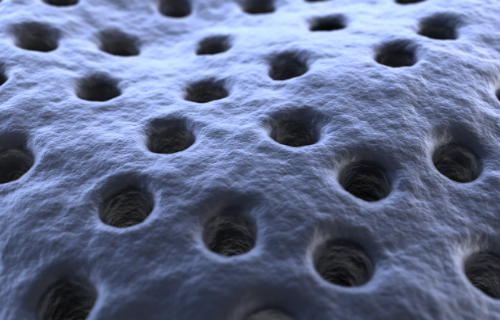Difference Between Pleurodesis and Decortication
Pleurodesis is removal of the space between the membranes of the lungs and the lungs themselves. Decortication is surgical removal of abnormal tissue that develops on the lung surface.

What is Pleurodesis?
Definition:
Pleurodesis is a method in which the pleural space is effectively removed so that the pleura are directly on top of the lungs.
Procedure:
A substance is injected into the pleural space to induce an inflammatory reaction that causes scar tissue to develop. This tissue then allows the visceral and parietal pleural membranes of the lung to fuse together and remain close to the surface of the lung. The space between the two membranes is taken away in this procedure.
Uses:
Pleurodesis is called for when individuals have continual problems with excessive fluid accumulating between the lungs and pleura. This often is a result of an inflammatory reaction that causes too much fluid to be present in the pleural space. It is used when a person keeps experiencing a collapsed lung because of a fluid problem.
Pros:
It helps keep the lung inflated because of the pleural cavity being removed. If your lung cannot expand and contract properly then you cannot breathe properly. This is a useful treatment for those individuals who have perpetual problems of effusions in the pleural space or who keep having a pneumothorax.
Cons:
There are possible complications of pleurodesis including a risk of infection, pain, and fever. It is possible that pus may accumulate.

What is Decortication?
Definition:
Decortication is a procedure in which the surgeon takes away fibrous tissue from the surface covering the lungs.
Procedure:
The surgeon cuts carefully into the chest cavity, avoiding the middle part of the chest under the breastbone. The fibrous layer is then excised from the lung surface and the lungs inflated to check for proper function.
Uses:
Decortication is used whenever the development of abnormal connective tissue on the lung makes it challenging for the person to breathe properly. The fibrous tissue causes a tightening that stops the lungs from expanding properly, which is why removing this layer is so beneficial for the person.
Pros:
It can help when there is tissue growth because of a condition like mesothelioma or another lung disease. These problems may result in fibrous tissue formation on the lung surface, which once removed, improves lung function.
Cons:
There are possible complications of the decortication procedure including air leaks that compromise lung function. There may be quite a bit of blood loss and the lung may collapse. Infection is a further risk of decortication. The mortality rate of decortication is a lot higher than in the case of pleurodesis.
Difference between Pleurodesis and Decortication?
Definition
Pleurodesis is a method in which the cavity between the pleural membranes is removed. Decortication is when abnormally developed fibrous tissue is cut away from the lungs.
Procedure
In pleurodesis, a chemical is injected into the pleural space causing the cavity to collapse. In decortication, a surgeon excises the fibrous tissue from the lung surface.
Benefits
A benefit of pleurodesis is it stops the continual development of extra fluid in the pleural space. A benefit of decortication is it allows the lungs to expand properly once the abnormal tissue is taken out.
Disadvantages
Disadvantages of pleurodesis include possible complications such as infection, pain, pus, and fever. Disadvantages of decortication include possible complications such as infection, collapsed lungs, air leaks in the lungs, and hemorrhage.
Mortality rate
Pleurodesis complications lead to lower mortality than decortication; the mortality rate is 3.7% after 90 days. Decortication has a higher mortality rate from complications when compared to pleurodesis, namely 9% after 30 days.
Table comparing Pleurodesis and Decortication

Summary of Pleurodesis Vs. Decortication
- Pleurodesis and decortication are two procedures that may be helpful in cases of lung disease and damage.
- Either pleurodesis or decortication may become necessary in cases of severe lung damage and diseases like lung cancer.
- Pleurodesis is concerned with removing the space that is found between the two membranes surrounding the lungs.
- Decortication is concerned with removing extra tissue that shouldn’t be present making it difficult for the lungs to expand.
FAQ
What is a decortication of the lung?
This is a method in which fibrous connective tissue, which has accumulated abnormally, is surgically excised from the surface of the lung. Doing decortication often allows the lungs to expand properly, and therefore, help with the person’s breathing ability.
Why is decortication performed?
Decortication becomes necessary when a buildup of unusual fibrous tissue on the lungs causes these organs to not be able to properly expand and contract, hampering the ability to breathe.
What is a pleurodesis procedure?
Pleurodesis is a way that the space between the lungs and the membranes is removed to better facilitate lung function to improve the breathing ability of the patient.
Why is pleurodesis performed?
Pleurodesis is needed when a person suffers from continual collapsed lungs causing them to struggle to breathe.
- Difference Between Rumination and Regurgitation - June 13, 2024
- Difference Between Pyelectasis and Hydronephrosis - June 4, 2024
- Difference Between Cellulitis and Erysipelas - June 1, 2024
Search DifferenceBetween.net :
Leave a Response
References :
[0]Kumar, Akshay, and Sachit Anand. "Lung Decortication." Statpearls (2020).
[1]Özer, Kadir Burak, et al. "The Effects of Pleural Decortication on Respiratory Functions of the Patients with Pleural Empyema." Southern Clinics of Istanbul Eurasia 29.2 (2018).
[2]Rodriguez-Panadero, Francisco, and Ana Montes-Worboys. "Mechanisms of pleurodesis." Respiration 83.2 (2012): 91-98.
